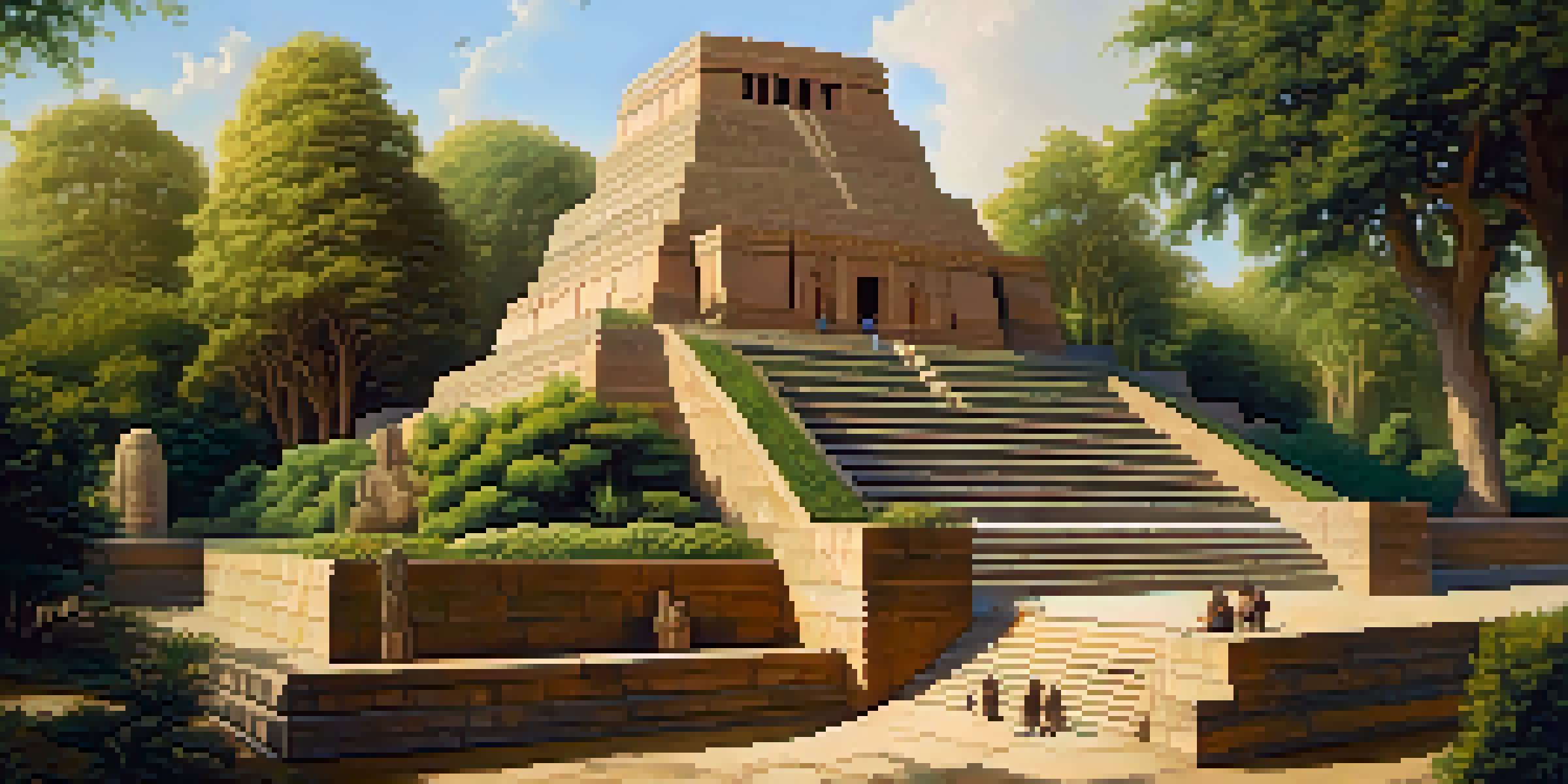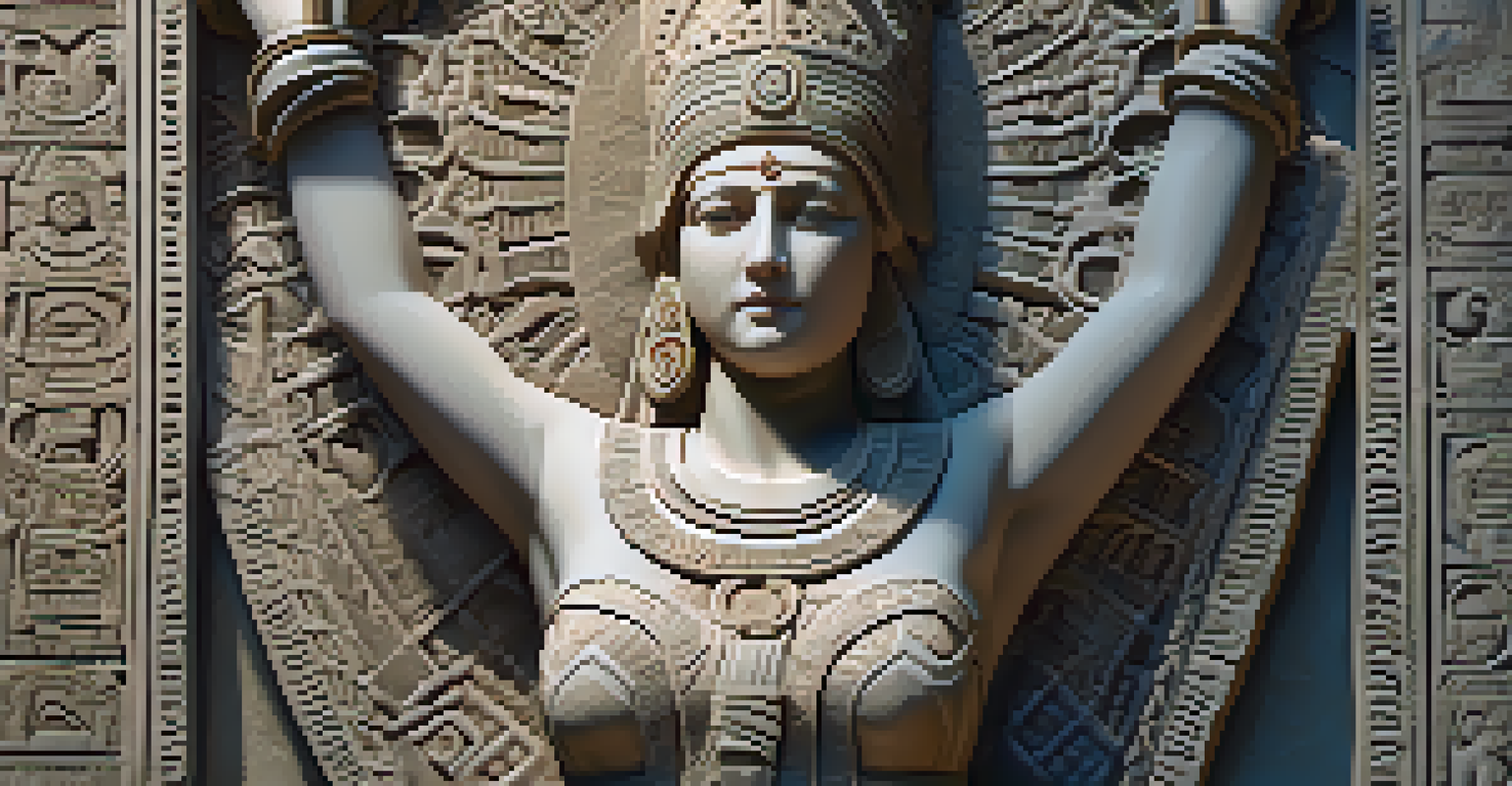Carving as a Religious Expression in Ancient Mesopotamia

The Role of Religion in Ancient Mesopotamian Society
Religion was a cornerstone of life in ancient Mesopotamia, shaping every aspect of society. The Mesopotamians believed in a pantheon of gods and goddesses, each governing different facets of life and nature. This deep-rooted spirituality influenced their artistic expressions, particularly in carving, which often depicted religious themes and deities.
Art is the most beautiful of all lies.
The temples, or ziggurats, were not just places of worship but also cultural hubs where art flourished. Carving was a way to honor the divine, with artisans creating intricate sculptures that conveyed their reverence. This connection between daily life and spirituality made carving an essential practice among the Mesopotamians.
As we delve into the specifics of carving, it becomes clear that these artistic endeavors were not mere decorations; they were vital expressions of faith. Each piece of carved art served a purpose, often intended to communicate with the divine or to commemorate significant religious ceremonies.
Materials and Techniques Used in Carving
Carving in ancient Mesopotamia involved a variety of materials, including stone, ivory, and wood. Stone was particularly favored for its durability, with limestone and alabaster being popular choices for creating lasting pieces. Artisans utilized tools made from copper and bronze to achieve precision in their work, showcasing their skill and artistry.

The techniques varied based on the material and the intended purpose of the carving. For instance, relief carvings were common on temple walls, depicting gods, mythological scenes, and ceremonial events. This method allowed for intricate storytelling, making the walls not just structural elements but narrative canvases.
Religion Shaped Mesopotamian Art
The intricate carvings created by Mesopotamian artisans were deeply intertwined with their religious beliefs, serving as expressions of faith and devotion.
Understanding these materials and techniques provides insight into the technological advancements of the time. The sophistication of Mesopotamian carving reflects not only the artisans' technical skills but also their commitment to creating works that would endure as expressions of their faith and culture.
Symbolism in Mesopotamian Carvings
Symbolism played a crucial role in Mesopotamian carvings, with each figure and motif carrying deep meanings. For example, the winged sun disk often represented divinity and protection, reflecting the connection between the heavens and earthly beings. Such symbols were not arbitrary; they were imbued with cultural significance and were designed to evoke specific emotions or responses from viewers.
Every artist dips his brush in his own soul, and paints his own nature into his pictures.
Religious symbols frequently adorned altars and statues, reinforcing the idea that these carvings were more than art—they were conduits of spiritual power. The placement of these carvings within sacred spaces further emphasized their importance in worship and daily life. They served as reminders of the divine presence, encouraging devotion and reverence among the people.
Through symbolism, carved artworks became a form of communication that transcended language. The images conveyed stories and beliefs, allowing even the illiterate to connect with the spiritual narratives of their culture. This aspect of carving highlights its role not just as an art form, but as a vital part of religious expression.
Depictions of Deities in Carvings
One of the most prominent subjects in Mesopotamian carvings is the depiction of deities. Each god was often represented with specific attributes that made them recognizable, such as horns, beards, or particular garments. Carvings of deities served to honor them and invoke their favor, making them central to religious practices.
For example, the goddess Inanna, the deity of love and war, was frequently depicted in elaborate carvings that emphasized her power and grace. These artistic representations were not merely decorative; they were integral to rituals and offerings, reinforcing the connection between the people and their gods. Through these carvings, worshippers expressed their devotion and sought divine intervention in their lives.
Symbolism in Carvings Communicated Beliefs
Each carved figure and motif held significant cultural meanings, allowing the Mesopotamians to convey spiritual narratives and connect with the divine.
The meticulous attention to detail in these carvings also reflects the artisans' understanding of the religious significance of their work. By capturing the essence of deities in stone, they created lasting tributes to the divine, ensuring that their cultural beliefs would be preserved for generations.
Carving as a Means of Commemoration
In addition to religious worship, carving served as a means of commemoration in ancient Mesopotamia. Important events, victories in battle, and the lives of notable figures were often immortalized through carved reliefs and statues. This practice ensured that significant moments were remembered and honored within the community.
For instance, royal inscriptions carved into stone served both as historical records and as declarations of power. These carvings were strategically placed in public spaces to reinforce the legitimacy of rulers and their divine right to govern. In this way, carving became a tool for both personal and political expression.
The act of creating commemorative carvings was not just about preserving history; it was also an act of devotion. By honoring past events and figures, the Mesopotamians reinforced their cultural identity and values, intertwining their history with their spiritual beliefs.
The Influence of Carving on Later Cultures
The artistic traditions established in ancient Mesopotamia had a profound influence on subsequent cultures in the region. As the cradle of civilization, Mesopotamia set the stage for artistic practices that would resonate through time. The techniques and themes found in Mesopotamian carvings can be seen echoed in later cultures, such as the Greeks and Romans.
For example, the use of relief carving to tell stories and honor the divine became a hallmark of later artistic movements. The emphasis on realism and detail found in Mesopotamian art paved the way for advancements in sculpture and architecture in subsequent civilizations. This legacy illustrates how the Mesopotamian approach to carving was foundational in the evolution of art.
Carving Preserved History and Culture
Beyond religious purposes, carvings immortalized important events and figures, reinforcing community identity and intertwining history with spiritual practices.
Moreover, the themes of spirituality and commemoration continued to be central to artistic expression in later cultures. The reverence for the divine and the importance of historical memory are threads that connect the art of Mesopotamia to that of future societies, showcasing the enduring impact of their carving traditions.
Preservation and Legacy of Mesopotamian Carvings
Despite the passage of time, many Mesopotamian carvings have endured, offering a glimpse into their rich cultural heritage. Archaeological discoveries have unearthed remarkable pieces, allowing us to appreciate the artistry and religious significance of these works. These artifacts serve as vital links to understanding the beliefs and practices of ancient Mesopotamian society.
Preservation efforts are crucial to ensuring that these carvings continue to be studied and appreciated. Museums and archaeological sites play an essential role in safeguarding this heritage, providing insights into the technological and artistic advancements of the time. The ongoing research into Mesopotamian carvings contributes to a broader understanding of ancient civilizations.

Ultimately, the legacy of Mesopotamian carving lies not only in the physical artifacts but also in the ideas and beliefs they represent. As we explore these ancient works, we gain a deeper appreciation for the spiritual expressions of a civilization that laid the groundwork for many aspects of modern culture.